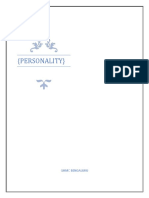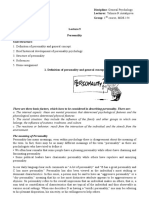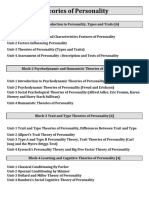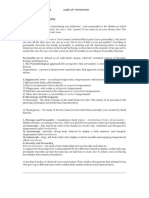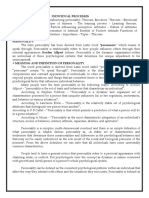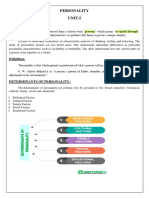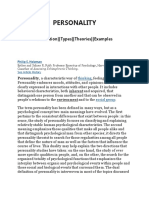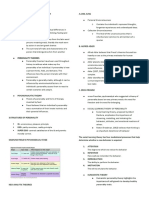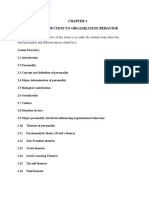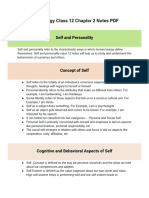0 ratings0% found this document useful (0 votes)
51 views13 pagesPersonality Assignment
Uploaded by
Hiradri Tanaya NandaCopyright
© © All Rights Reserved
We take content rights seriously. If you suspect this is your content, claim it here.
Available Formats
Download as PDF or read online on Scribd
0 ratings0% found this document useful (0 votes)
51 views13 pagesPersonality Assignment
Uploaded by
Hiradri Tanaya NandaCopyright
© © All Rights Reserved
We take content rights seriously. If you suspect this is your content, claim it here.
Available Formats
Download as PDF or read online on Scribd
You are on page 1/ 13
Se RMP OF INE Sen OF Ulal OF THE SOUIU,
The concept of personality -
The term personality has its orgin from the Latin word persona which
means a “mask’. It can be also called as a theatrical mask used by the actors in
the drama while playing the roles of different characters. But, in our daily life, we
are using the term personality mostly to mean the overall get up of an individual
giving more importance to his/her physical appearance or attractiveness.
How can we define the term personality ? It can be defined as “the sum-total
of an individuals attributes or qualities”. These attributes include all those that
constitute the whole person, starting from his/her physical appearance to his nature,
temperament, interest and choice pattern, liking and dislikings, gestures and
postures, communication style, dressing sense, attitude, action and behaviour
etc. All these comprises one’s personality.
Let us put a glance to the term “mask”. what happens when we use a mask
? It replace our original face and we use it to play the role of some other person
that is not exactly, the “me”. We are also required to change our voices and many
other things to suit the “targeted character” in the drama. Once our “roles” are
over, we returned back to our original role and personality. What is most important
here is that this temporary “role playing behaviour can bring minor changes in our
nature and temporament also. The possibilities are always there and it cannot be
ignored.
Can there be a distrinction between our Inner self and outer self ? This
has been the frequently raised question in many minds ? The reality is that there
is a definite gap between these two selves. The reason being, we, as human
beings have a born tendency to appear nice before others. We all want to show
socially approved pattern of behaviour because in our sub-conscious mind, the
et social appr .
a en of behavion 'S always there, This desire motivate US to Snow
a neon our ale This indicae the fact that most of us uSuallY
4399? Self and the external self to fulfill some of our personal,
© ological and social ;
cholog) Needs. This, certainly justify the use of the term- ‘mask
create
os
ity Defin
jersonality ined
The term ey has been defined differently by many eminent
_chologists, aoe scientists and Sociologists. The following are some of the
“st popular definitions of the term Personality.
According to George. Herbert (1936), “Personality is the product of our
interactions with varieties of people at different situations of our life, but the
major influence being exerted by family members.”
) According to Mc Arthur, (1985)., the term personality can be defined as “the
relatively consistent and enduring aspects of our behaviour that cause US to
resemble others in some ways and to be unique in other ways.”
ii) According to warren, (1962) personality can be defined as “the entire mental
organization of a human being at any stage of his development.”
According to Nelson & Miller (1995), personality can be defined as “an
individual's unique and relatively stable patterns of behaviour, thoughts and
emotions.”
¥) Morton Prince has defined the term personality as “the sum-total of all the
bilogical innate dispositions, impulses, tendencies, appetites and instincts of
the individual and the acquired disposition and tendencies acquired by
experience.”
vi) According to G.W. Allport, personality can be defined as “the dynamic
organization within the individual of those psychophysical systems that
determine his unique adjustment to his environment.”
Allport’s definition is considered to be one of the most exhaustive definition
f personality. This definition has focussed on three major aspects like the following :
a) Personality as the dynamic organization,
b) Psychophysical system and
c) One's unique adjustment to his.
summarized as follows : Personality is the sumn-total of
n individual which are dynamic and subject to
e adjustment to his/her adjustment.
nality is a social phenomenon
‘cial interaction. It indicates the uniqueness of
an individual. Personality is never static, it is subject to change. It is the sum-total
of all the traits and characteristics, qualities or attributes of a person. According to
the Interactionists Perspective, our behaviour in any given situation is usually
a complex function of our internal factors and the situational factors in the
environment
This definition can be
the physical and mental traits of al
change and they help in making uniqu'
All these definitions point out the fact that persor
and it is greatly influenced by our st
world around us.
This perspective has now been accepted by most psychologists. However,
certain traits of our personality continue in a consistent manner. The factor of
individual difference carries a great value in this regard.
Approaches to study personality :
How to study one's personality ?
It is a fact that most of the characteristics that identify and define us as
individuals are the product of social interaction. In as much as each individual
interact with others throughout his/her life-span, and because no two interactions
are the same, personality undergoes a constant process of modification. In addition
to this, our own involvement in the roles we play is also likely to create some kind
of effect on us and upon our relationships with others. in this process, as we move
from one situation to another, and from one role to another, we reveal many
aspects of ourselves - our personality, to others to ourselves as well.
There are mainly four major approa ly personali
ches to study personality. i
lowing: ity. These include
i) The type and the Trait Approach
ii) The Psychodynamic Approach
iii) The Behaviourist Approach
iv) The Humanistic Approach
i) The Type and the Trait Approach
What is the necessity to understand and to differentiate between different
types of personality pattern ? Why psychologists are interested to categorise people
on the basis of their personality characteristics ? Even though we know that there
can be no comparision between two individuals, still then, there are certain traits
or characteristics that may be common. The term type refers to categories where
as the term trait refers to characteristic pattern. Approaches to study personality
‘on the basis of both types and traits can throw some light in finding out the
similarities or differences, if any, among individuals in relation to their behavioural
dimension.
The first attempt to study personality on the basis of types was made by the
Greek physician Hippocrates. He had the belief that the body constitution of the
individual determines the way he or she is expected to behave. So, he had classified
personality types under four categories. They are the following :
i) The Sanguine : Those who are cheerful, active, quick in action.
ii) The plegmatic : Those who are slow, dull, calm and inactive.
iii) The Choleric : Those who are short tempered,- Irritable,
aggressive.
iv) The melancholic : Those who are sad, depressed and pessimistic. ;
Such a typological classification of personality was made by Hippocrates on
the basis of the predominant fluid in the body of the particular individual, i-e.,
whether it is blood, phlegm, yellow bile or black bile.
(after Hippocrates, the next attempt to classify personality was taken by
Kretschmer(1925). He was @ psychiatrist by profession and he wanted to to classify
Personality on the basis of an individual's body form and structure. He had observed
both the normal individuals as well as mental patients. According to him,
a
Schizophrenic and manic depressive patients have different types of body
Constitution. Because certain body types gives rise to certain types of mental
disorders (He then classified normal individuals under 3 categories which include
the following )
i) Asthenic Type: — These people are tall, thin. They are shy, eee,
gentle, idealistic and imaginary, non-expressive.
ii) Athletic Type : These people are tall, well-built, active, joyful, practical
and adjustive, have patience.
iii) Pkynic Type : These people are short statured, fatty, round-faced,
thick-necked. Are jovial, easy going, mobile, tolerant,
popular with sense of humou,r are expressive.
So, like Hippocrates, Kretschmer also believed that there is direct and positive
Correlation between our body structure with that of our nature and temperament.
After Kretschmer, the next classification of personality was made by sheldon
in the year 1942. His theory is popular in the name of the somato type theory
of personality. Sheldon strongly believed the interlink between one’s body
Constitution with personality type.
He classified human personality into 3 types like :
i) Endomorphy : Fond of food, like comfort and relaxation, jovial,
amiable, are apprehensive with sense of insecurity.
iil) Mesomorphy : Like hard work, adventurous, Pain-staking, calm and
cool, Energetic, competitive mind etc.
iii) Ectomorphy : Unsocial, Inactive, thoughtful, shy, non-adventurous,
impatient.
Shelon’s classification was based on the belief that there is close connection
between one’s Physique and temperament.
These classifications of Personality made by Hippocrates, Kretschmer and
Sheldon, even if they are not accepted to-day, stile then credit should be given to
|
}
at least for initiating the doo
re nal "t0.a deeper understandng and study of human
Next important typological diy)
sio
_ even to day his classification ms epi Oy pcos
ung: EV aS accepted bi hologists and other
at hologists Y Psychologis
sonal all eer one has occupied a Prominent place in understandng
tne ae «The Extroverts Personality. Jung has classified personality into two
ike : The and the Introverts basing on their overall tendency
wie responding to the external world,
by Carl
General Characteristics of Extroverts :
) Easy and outgoing vi) Take interest in other people
) Sociable and friendly Vii) Like to be involved in new tasks
i) Lively and active Vili) Sportive and Jovial
\) Men of action and practical ix) Expressive
Insensitive to social criticism
x) Less emotional
These are the general characteristics of Extroverts. They prefer to give more
portance to their, success and want to avoid failure. They do not feel easily
embarassed or insulted. They seemed to be more confident of themselves and
ke to discuss their views with others. Leaders, actors, entrepreneurs belong to
this group.
General characteristics of Introverts
\) Like to stay in their own world (ix) Self-critical
Imaginative (x) _ Repressive type
') Socially sensitive (xi) Thoughtful/moody
’) Shy, reserved type (xii) Magnify failures
") Less expressive (xiii) Not very friendly
‘) Indecisive (xiv) Tendency to compare
© Psychology, Class-X!l ———
vil) Prefer to stay alone (xv) Can't easily mix with others
(xvi) Emotional
These are the overall characteristic pattern of the introverts. They usually do
not want to talk more and they never prefer to tell their personal or private problems
or feelings to others. It is commonly assumed that scientists, philosophers, poets,
artists, painters etc. belong to this group.
ality was based on his personal observa!
in his clinical field.
viii) Self analytical
Jung's classification of persons tions of
people in different settings as well as his experiences i
In oul
to classify people strictly into any spe
vulnerable to situations. At different si
and contradictory attitude and behaviot
think of another category the Ambiverts.
The Ambiverts - This category of people possess characteristics of both
the Extroverts and Introverts. Depending upon the need and demand of the
situation, they exhibit different characteristics. Practically speaking, the majority
of the people falls in this category. Hence, the same individual show both the
tendency or characteristic pattern of extroversion and Introversion.
This typological division of personality is just an explanation of human nature
and temperament on the basis of their overall reaction and behaviour pattern. As
personality is multidimensional, this typological division is not at all exhaustive in
explaining the concept of personality.
Trait Approach - This approach focusses mainly upon identifying the key
dimensions of personality along which people differ from each other. If we are
able to identify these dimensions, then it will become easy on our part to find out
“how much they differ from other’. The term trait’ refers to a stable and enduring
attributes of a person that are more or less consistent and are revealed in different
situations. It refers to a common tendency on the part of an individual that motivates
him to act and behave in typical ways. It has been estimated that more than
rr real life situation, we have observed that it is practically very difficult
ecific category. Because, human beings are
ituations they exhibit completely opposite
ur, Rather, it will be more appropriate to
;
a
000 traits can be describe
40, dy these trats, A d. Allport and Warren have done extensive research
to study » Apart from these tw
explain the t /0, cattell, and Eyesenck et. al have also
tried to erm personality on the basis of “traits”. )
n this context, c ,
I attell has differentiated between two different type of traits
namely-
i) Source Traits and ii) _—_ Surface traits
By source traits, it is eats those attributes or qualities that are there ata
deeper level and these traits are the actual traits of a person. By surface traits,
cattell believed that these are the attributes of a person as exhibited by him directly
in his action pattern/
According to this trait approach, these traits determine the differences In
personality dimension. It is only because, these traits are found to be relatively
stable over time and they are reflected more or less consistently across situations.
Hence, depending upon the strength and weakness of these traits along with their
combination, we can identify the basic differences among individuals.
While discussing the salient features of this trait approach, itis very important
to know the works of Allport, Cattell and Eyesenck whose contributions were note
worthy.
Contributions of G. Allport :
Gordon Allport is considered as the champion of the trait approach. He was
of the opinion that an individual's personality can be divided into many different
categories and these categories vary in relation to their strength and importance.
He had explained three major categories of traits in this regard. These traits include
the following :\
i) The Central Traits
ii) The Cardinal Traits
iii) The Secondary Traits
The Central Traits are generally few in number. Yet, these are very strong traits
and they are strong enough not to be influenced or affected by situational factors.
Practically speaking, these traits determine the “uniqueness” in an individual's
Personality.
Cardinal Traits are those traits that are limited to either one or two dominant
traits that determine the entire personality of an individual.
In contrast to the central and the cardinal traits, the secondary co are
those Uraits that exert very little and weak influence upon ne behaviour ce an
individual. These secondary traits are considered to be the least important traits of
one's personality. )
Later on Allport has developed the concept of functional autonomy in the
year 1965, to explain the reason as to why many individuals show interest to show
definite patterns of behaviour, intentionally in order to get desired results.
Allport viewed that the way an individual react and respond to different
situations is dependent upon his/her personality traits. While expressing these
traits, parental training and social conditioning play an important role. Because of
this, people having same type of personality traits may express it differently.
Contributions of R. B. Cattell -
Raymond Cattell has proposed his own unique trait theory of personality
after conducting research on thousands of persons to find out the key dimensions
of personality. He used the factor analysis technique to analyse the response
pattern of his subjects. His intention was also to find out the Possibility that might
exist between different traits on the basis of which he could identify important
Cluster of traits.
With this intention in mind cattell did collaborative work with Dreger in the
year 1977 and was able to identify sixteen source traits and 35 surface traits
which he considered as more stable traits less affected by environmental factors.
He described these sixteen traits in terms of opposing tendencies like disciplined
vrs undisciplined, cool vrs. calm etc. Later on, he used these materials for assessing
personality a the form of a self-administered questionnaire which is popularly
known as Sixteen-Personality Factor Questionnaire (SPFQ).
Contributions of H. J, Eysenck -
Eysenck is a popular British Psychologist. He attempted to describe the basic
dimensions Of personality. He wanted to classify various dimensions into major
dimensions. These major dimensions include many other contractory traits. These
two dimensions include the following:
i) Neuroticism Vrs Emotional Stability
ii) Extraversion Vrs Introversion
i) Neuroticism Vrs Emotional Stability :
As the name indicates, both the terms stand opposite to each other. Neurotic
people are those who are anxious, tensed, restless, moody and somewhat
emotionally unstable where as those who é are emotionally stable, they have good
control over their emotions and feelings. They appear to be calm, stable, easy and
balanced. Both of them stand at the two extremes of a scale,
ii) Extraversion Vrs Introversion :
The tendency and behaviour pattern of both the categories are opposite to
each other. While the Extroverted people are active, energetic, outgoing,
impulsive, decisive & friendly etc., the Introverts are socially withdrawn type,
shy, reserved, reflective, solitude-seeking, indecisive etc.
Later on, after engaging himself in other research activities to know more
about the functioning of the traits and its resulting impact on personality pattern,
he has proposed the third dimension - psychotism. According to him, a person
whose personality dimension is more towards psychotism, behaves in a typical
manner that can be well differentiated from the other two dimensions. These
people behave in an anti-social manner, they are emotinally unstable and
unpredictable in relation to their personality pattern.
fF th
A comparision between the ‘type’ and the ‘trait’ Bepiossilateeetas the
SuPerionity of the later. A descriptive approach, no doubt, helps in ovina we
Concepts, varieties etc., But a more scientific and objective approach sy an
better results. To conclude, trait approach to study personality is definitely
Promising approach.
= itely shows the
An evaluation of both the approaches by psychologists definitely
Preference towards the trait approach as it was accepted by almost majority ct ‘dea
Psychologists. But, this does not mean that this approach is free from shortcomings.
One such demerit is connected to the aspect that it fails to explain the ‘how’and
‘why’ factor of behaviour, i.e. what are the sources of the development of these
traits and how they affect human behaviour and finally why studying te factors
are important. Inspite of these limitations, the trait approach has it’s own importance
in explaining basic dimensions of personality, This approach has become successful
in inviting more comprehensive research relating to identifying
other important dimensions of personality.
New Developments in Personality Research
The contributions of Paul Costa and Robert Mc Crae and Zuckerman (1994)
has created a steer among psychologists with their popular Big Five Dimensions
of personality. Why they are so named? What justification we can give? These
three renowned scholars have identified five basic dimensions of personality that
they consider central to final research on personality. These five key dimensions
include the following :
i) | Openness to Experience
ii) Extraversion
iii) | Agreeableness
iv) Conscientiousness
v) Emotional Stability
i) Openness to Experience : Individuals high on this dimension are found to
be openmined, flexible, imaginative, open to new ideas, interested to explore new
things, simple and down-to-earth people. They donot want to limit themselves to
any kind of narrowness that may create barrier to the path of their exposure to the
big world.
ii) Extraversion : It is same as that of Jung's concept of Extroversion.
Individuals high in this dimension are found to be sociable, friendly, energetic,
enthusiastic, outgoing, talkative and very much expressive. Individuals who score
less in this dimension possess all those traits of an Introvert who are shy, reserved,
less talkative, inexpressive, socially inactive etc.
iii) Agreeableness : This dimension is expressed in the form of being a good
human being with good nature. These people very much helpful, reliable, co-
operative & supportive. Individuals: low in this dimension show the reverse of
these traits or qualities.
iv) -Conscientiousness : Individuals who are high on this dimension are found
to be systematic, well-organized, responsible, disciplined, careful, duty conscious
and ethically strong.)Those who score less or are low in this dimension exhibit just
the opposite of these qualities.
v) Emotional Stability : Individuals who are emotionally stable, are found to
be calm and composed, balanced, emotionally mature and know the art of when
to talk and when not to. These people also recognise other’s emotions and set
their interaction pattern accordingly. On the contrary, those who are emotionally
unstable, are found to be nervous, anxious, tensed, stressed, imbalanced and
showing abnormal behavioural tendencies.
Many researchers still believe these “Big Five factors” as the key dimensions
of our personality and they also claimed that people across cultures can also be
evaluated quite correctly on the basis of these five central dimensions. According
to (Hogan & Roberts, 1996), these dimensions can also explain the causes behind
various forms of behaviour and by this, the shortcomings of the previous trait
approaches can be ignored. However, there are psychologists, who still are not
a little difference of
as acclaimed greater
ality psychologists.
to continue
ready to accept this model whole heartedly. But, in spite of
Opinion about this final description of personality dimension, it hi
acceptance among Majority of the psychologists including person
At least, it can provide sufficient impetus to those who are ready
further research in this area. yy
You might also like
- PERSONALITY - Meaning, Definition & CharacteristicsNo ratings yetPERSONALITY - Meaning, Definition & Characteristics4 pages
- EDU 100 Unit III Personality Type and TRNo ratings yetEDU 100 Unit III Personality Type and TR14 pages
- Introduction To Personality and Its Factors: Home About Us Administration Programmes Admission Photo Gallery Contact UsNo ratings yetIntroduction To Personality and Its Factors: Home About Us Administration Programmes Admission Photo Gallery Contact Us7 pages
- Week 4 C2 Personality Development & It's ComponentsNo ratings yetWeek 4 C2 Personality Development & It's Components5 pages
- Personality Development and Soft SkillsNo ratings yetPersonality Development and Soft Skills25 pages
- PDE Chapter 1 Personality Development It S Components (2) 2No ratings yetPDE Chapter 1 Personality Development It S Components (2) 259 pages
- Discipline: General Psychology, Lecturer: Yelnura N.Autalipova Group: 1st Course, MDE 154No ratings yetDiscipline: General Psychology, Lecturer: Yelnura N.Autalipova Group: 1st Course, MDE 1547 pages
- PSY1001 Personality IndividualDifferences 2023 PostlectureslidesNo ratings yetPSY1001 Personality IndividualDifferences 2023 Postlectureslides72 pages
- Chapter 2: Personality: ST Roop Convent School Class 12 - PsychologyNo ratings yetChapter 2: Personality: ST Roop Convent School Class 12 - Psychology4 pages
- PS416 - 945 - Personality Theory in ContextNo ratings yetPS416 - 945 - Personality Theory in Context41 pages
- Kiei Full Write Up With Introduction-Converted-1No ratings yetKiei Full Write Up With Introduction-Converted-125 pages
- Chapter 2 - Self and Personality Ncert Grade 12 Psychology NotesNo ratings yetChapter 2 - Self and Personality Ncert Grade 12 Psychology Notes8 pages
- Psychology Class 12 Chapter 2 Notes PDFNo ratings yetPsychology Class 12 Chapter 2 Notes PDF12 pages





